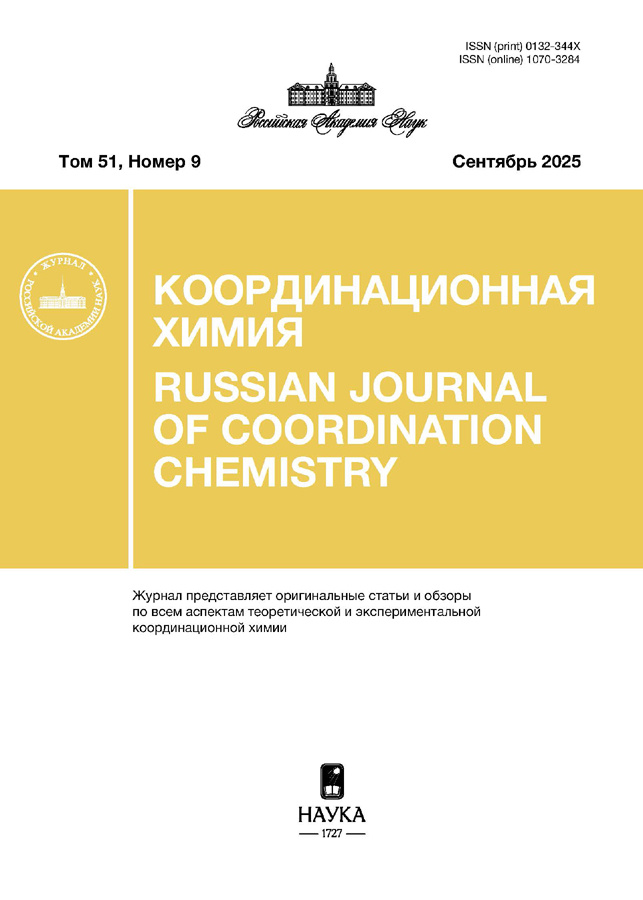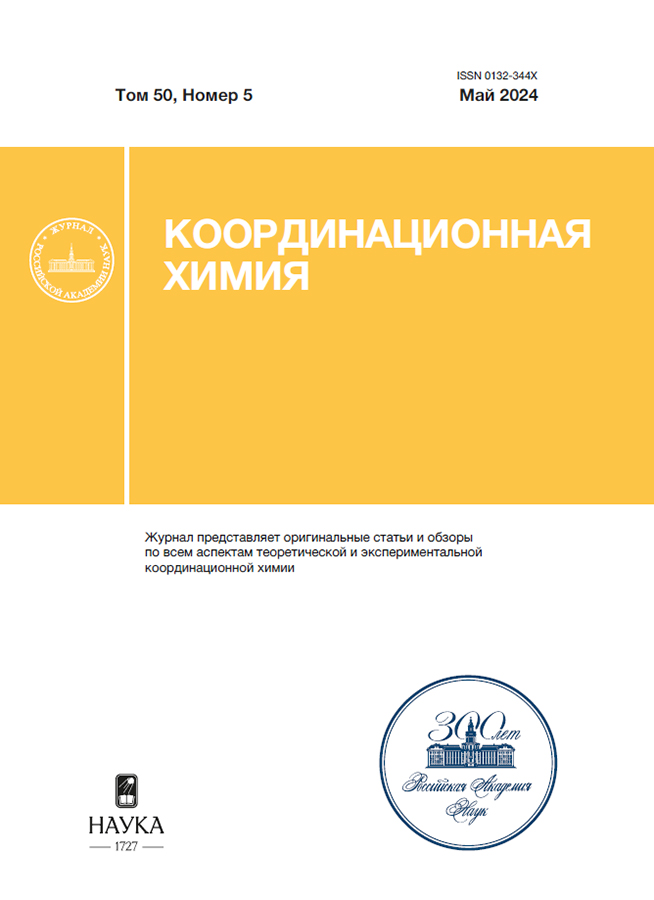Синтез и исследование моноарилгидразиноаценафтенонов и комплекса никеля на основе пиридин-замещенного производного
- Авторы: Бакаев И.В.1, Комлягина В.И.1,2, Ромашев Н.Ф.1, Гущин А.Л.1
-
Учреждения:
- Институт неорганической химии им. А.В. Николаева СО РАН
- Новосибирский научно-исследовательский государственный университет
- Выпуск: Том 50, № 5 (2024)
- Страницы: 287-295
- Раздел: Статьи
- URL: https://rjonco.com/0132-344X/article/view/667596
- DOI: https://doi.org/10.31857/S0132344X24050012
- EDN: https://elibrary.ru/NKOJGP
- ID: 667596
Цитировать
Полный текст
Аннотация
При взаимодействии аценафтенхинона с соответствующей солью арилгидразина синтезированы три моноарилгидразиноаценафтенона: моно(2-пиридил)гидразиноаценафтенон (Py-mhan, L1), моно(4-цианофенил)гидразиноаценафтенон (4-CN-Ph-mhan, L2) и моно(3,4,6-трифтор-2-пиридил)гидразиноаценафтенон (FPy-mhan, L3); соединения L2 и L3 получены впервые. Дальнейшее взаимодействие L1 с хлоридом никеля в стехиометрии 2 : 1 приводит к октаэдрическому комплексу [Ni(Py-mhan)2] (I), в котором Py-mhan выступает в качестве тридентатного лиганда. Все полученные соединения охарактеризованы с помощью элементного анализа, спектроскопии ИК и ЯМР 1H, циклической вольтамперометрии, кристаллическая структура L3 и I определена с помощью рентгеноструктурного анализа.
Ключевые слова
Полный текст
Об авторах
И. В. Бакаев
Институт неорганической химии им. А.В. Николаева СО РАН
Email: nikolaj.romashev75@gmail.com
Россия, Новосибирск
В. И. Комлягина
Институт неорганической химии им. А.В. Николаева СО РАН; Новосибирский научно-исследовательский государственный университет
Email: nikolaj.romashev75@gmail.com
Россия, Новосибирск; Новосибирск
Н. Ф. Ромашев
Институт неорганической химии им. А.В. Николаева СО РАН
Автор, ответственный за переписку.
Email: nikolaj.romashev75@gmail.com
Россия, Новосибирск
А. Л. Гущин
Институт неорганической химии им. А.В. Николаева СО РАН
Email: nikolaj.romashev75@gmail.com
Россия, Новосибирск
Список литературы
- Wang J., Soo H.Sen, Garcia F. // Commun. Chem. 2020. V. 3. № 1. P. 133.
- Fomenko I.S., Gushchin A.L. // Russ. Chem. Rev. 2020. V. 89. № 9. P. 966.
- Komlyagina V.I., Romashev N.F., Besprozvannykh V.K. et. al. // Inorg. Chem. 2023. V. 62. № 29. P. 11541.
- Romashev N.F., Mirzaeva I.V., Bakaev I.V. et. al. // J. Struct. Chem. 2022. V. 63. № 2. P. 242.
- Romashev N.F., Bakaev I.V., Komlyagina V.I. et. al. // J. Struct. Chem. 2022. V. 63. № 8. P. 1304.
- Fedushkin I.L., Skatova A.A., Chudakova V.A., Fukin G.K. // Angew. Chem. Int. Ed. 2003. V. 42. № 28. P. 3294.
- Fedushkin I.L., Maslova O.V., Baranov E. V., Shavyrin, A.S. // Inorg. Chem. 2009. V. 48. № 6. P. 2355.
- Bendix J., Clark K.M. // Angew. Chem. Int. Ed. 2016. V. 55. № 8. P. 2748.
- Bernauer J., Pölker J., Jacobi von Wangelin A. // ChemCatChem. 2022. V. 14. № 1. P. e202101182.
- Chacon-Teran M.A., Findlater M. // Eur. J. Inorg. Chem. 2022. V. 2022. № 30. P. e202200363.
- Johnson L.K., Killian C.M., Brookhart M. // J. Am. Chem. Soc. 1995. V. 117. № 23. P. 641415.
- Leatherman M.D., Svejda S.A., Johnson L.K., Brookhart M. // J. Am. Chem. Soc. 2003. V. 125. № 10. P. 3068.
- Bridges C.R., McCormick T.M., Gibson G.L. et al. // J. Am. Chem. Soc. 2013. V. 135. № 35. P. 13212.
- Zhai F., Jordan R.F. // Organometallics. 2017. V. 36. № 15. P. 2784.
- Wu R., Klingler Wu, W., Stieglitz, L. et. al. // Coord. Chem. Rev. 2023. V. 474. № 1. Art. 214844.
- Fedushkin I.L., Nikipelov A.S., Morozov A.G. et. al. // Chem. Eur. J. 2012. V. 18. № 1. P. 255.
- Yakub A.M., Moskalev M.V., Bazyakina N.L., Fedushkin I.L. // Russ. Chem. Bull. 2018. V. 67. № 3. P. 473.
- Arrowsmith M., Hill M.S., Kociok-Köhn G. // Organometallics. 2011. V. 30. № 6. P. 1291.
- Saini A., Smith C.R., Wekesa F.S. et al. // Org. Biomol. Chem. 2018.V. 16. № 48. P. 9368.
- Tamang S.R., Cozzolino A.F., Findlater M. // Org. Biomol. Chem. 2019. V. 17. № 7. P. 1834.
- Gushchi, A.L., Romashev N.F., Shmakova A.A. et. al. // Mendeleev Commun. 2020. V. 30. № 1. P. 81.
- Fomenko I.S., Gongola M.I., Shulʹpina L.S. et. al. // Catalysts. 2022. V. 12. № 10. P. 1168.
- Romashev N.F., Bakae I. V., Komlyagina V.I. et. al. // Int. J. Mol. Sci. 2023. V. 24. № 13. P. 10457.
- Bakaev I.V., Romashev N.F., Komlyagina V.I. et. al. // New J. Chem. 2023. V. 47. № 40. P. 18825.
- Zhou J.L., Xu Y.H., Jin X.X. et. al. // Inorg. Chem. Commun. 2016. V. 64. P. 67.
- Zhou J.L., Sun H.W., Yin D.H. et. al. // J. Mol. Struct. 2017. V. 1134. P. 63.
- Gao, Q., Song Y., Zheng C. et. al. // J. Mol. Struct. 2020. V. 1214. P. 128228.
- Su Y.X., Zhang C.Z., Song M.X. // Acta Crystallogr. C. 2017. V. 73. № 6. P. 458.
- Sheldrick G.M. // Acta Crystallogr. A. 2015. V. 71. № 1. P. 3.
- Sheldrick G.M. // Acta Crystallogr. C. 2015. V. 71. P. 3.
- Hübschle C.B., Sheldrick G. M., Dittrich B. // J. Appl. Crystallogr. 2011. V. 44. № 6. P. 1281.
- Soldatov D.V. // Mendeleev Commun. 1997. V. 7. № 3. P. 100.
- Bose N., Lynton H. // Can. J. Chem. 1973. V. 51. № 12. P. 1952.
- Zhang H., Fang L. // Acta Crystallogr. E. 2005. V. 61. № 1. P. m1-m2.
- Wriedt M., Jess I., Näther C. // Acta Crystallogr. E. 2010. V. 66. № 7. P. m780.
- Van Damme N., Lough A.J., Gorelsky S.I., Lemaire M.T. // Inorg. Chem. 2013. V. 52. № 22. P. 13021.
- Niklas J.E., Farnum B.H., Gorden J.D., Gorden A.E.V. // Organometallics. 2017. V. 36. № 23. P. 4626.
Дополнительные файлы

















